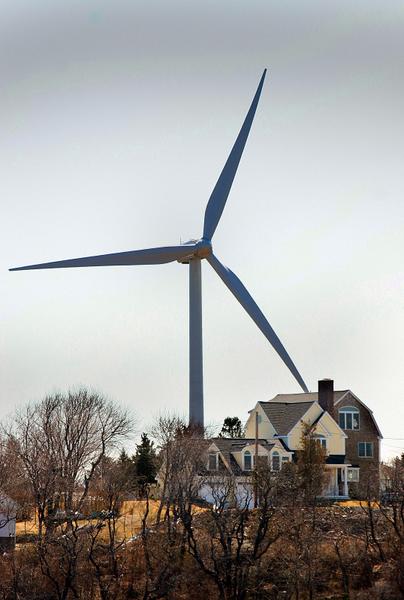| Wind Watch is a registered educational charity, founded in 2005. |
Four planned wind turbines get state blessing
Translate: FROM English | TO English
Translate: FROM English | TO English

One of Hull’s two land wind turbines is on a former landfill, towering over Orleans Street. GREG DERR/The Patriot Ledger
State officials have given Hull the first go-ahead it needs to build four wind turbines about 1 1/2 miles off Nantasket Beach.
Ian Bowles, secretary of the Executive Office of Energy and Environmental Affairs, opened the way Monday for the town to set up offshore wind turbines capable of producing enough electricity to power the whole town.
“Global climate change, sea level rise, dependence on foreign oil and the health impacts of local and regional air pollution create an urgent need for sustainable alternatives to energy produced from fossil fuels,” Bowles wrote in a letter giving the plan initial state approval.
The turbines would be the first grouping of offshore windmills in the country, Hull Town Manager Phil Lemnios said.
“One of the consultants told me the waters off New England are the Saudi Arabia of wind,” Lemnios said. “If you look at the consistency and quality of the wind, it is phenomenal for the production of energy.”
Hull already operates two land-based turbines, which generate enough power to meet about 12 percent of the town’s electricity demand.
The new turbines are planned for a shoal known as Harding Ledge, a largely submerged rock outcrop off Nantasket Beach, and an important lobstering area.
Hull fishermen have questioned where the turbines would go up and their potential effect on fishing. That’s an issue that will be explored in an environmental impact statement, the next phase for the proposal.
The offshore turbines would be able to produce a total of 15 megawatts of power.
“It would put them in a position to be energy self-sufficient,” Sen. Robert Hedlund, R-Weymouth, said of the plan.
Environmentalists praise the idea and say the turbines should be built pending studies on potential environmental impacts on marine and bird life.
“It’s a terrific proposal,” said Sue Reid, staff attorney for the Conservation Law Foundation. “Hull is staking itself out as a true leader in the clean energy revolution.”
With few options for more land-based turbines in Hull, the town hopes to use offshore turbine technology developed and popularized in Europe, Lemnios said. A $1.7 million grant from the Massachusetts Technological Collaborative underwrote a study by ESS Group of Wellesley.
Before offshore turbine construction can begin, studies must be performed to determine whether the ocean floor could support the towers and how the construction might affect lobsters and other marine wildlife, ESS Group officials said.
It cost $1.2 million to build Hull’s first, 660-kilowatt wind turbine on Pemberton Point near Hull High School. Hull’s second, 1.8-megawatt turbine cost $3 million.
The cost to build what many are already calling Hull Wind III has yet to be determined, Lemnios said.
By Tom Benner
12 February 2008
This article is the work of the source indicated. Any opinions expressed in it are not necessarily those of National Wind Watch.
The copyright of this article resides with the author or publisher indicated. As part of its noncommercial educational effort to present the environmental, social, scientific, and economic issues of large-scale wind power development to a global audience seeking such information, National Wind Watch endeavors to observe “fair use” as provided for in section 107 of U.S. Copyright Law and similar “fair dealing” provisions of the copyright laws of other nations. Send requests to excerpt, general inquiries, and comments via e-mail.
| Wind Watch relies entirely on User Funding |
 (via Stripe) |
 (via Paypal) |
Share:

